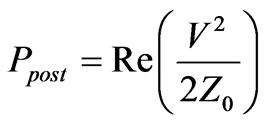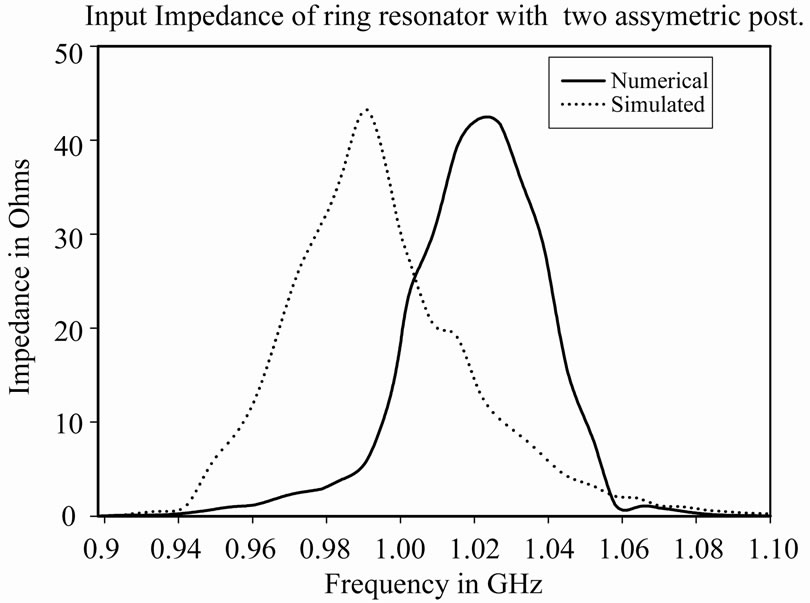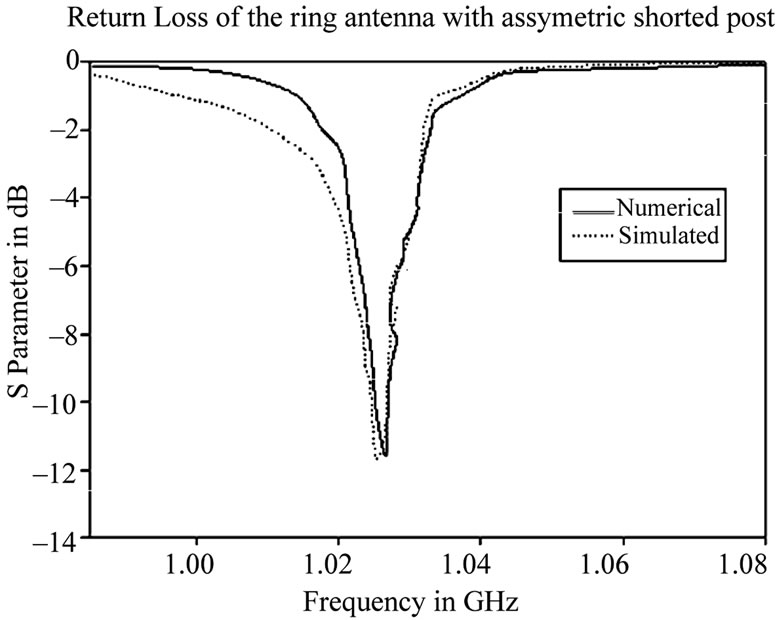Journal of Electromagnetic Analysis and Applications
Vol. 3 No. 3 (2011) , Article ID: 4395 , 4 pages DOI:10.4236/jemaa.2011.33015
Analysis of Input Impedance of Asymmetrically Loaded Annular Ring Antenna
![]()
1Department of Physics, Chitkara University, Barotiwala, India; 2Department of Physics, Jaypee University of Information Technology, Waknaghat, India; 3EIS-MD & P, Tata Consultancy Services, Salt Lake Electronics Complex, Kolkata, West Bengal, India.
Email: sunil_khah@rediffmail.com, madhurikam@gmail.com
Received February 8th, 2011; revised February 15th, 2011; accepted March 7th, 2011.
Keywords: Loaded Microstrip Antenna, Cavity Model, Feed Point, Input Impedance, Return Loss
ABSTRACT
In this communication the numerical modelling for input impedance of an annular ring antenna is done. The cavity model is used for the analysis and the post is loaded asymmetrically at a point from the centre of the ring. The numerical model formed is verified with the results of IE3D model based on method of moments. The loading of antenna can be used to design broadband antennas by enhancing the bandwidth of antennas.
1. Introduction
Shorting posts in microstrip antennas have recently come into use in order to take the advantage of different properties such as dual frequency, tenability and compactness [1-3]. Different geometries such as triangular and square patch microstrip antennas have been studied for dual band operation and to enhance bandwidth [4-6].
Depending upon the applications a shorting pin may be located at the edge or at the centreline of the patch. The loading can be called as symmetric and asymmetric based on the location of the posts. The asymmetric and symmetric loadings are described in [7-9]. The analysis [8,10] shows that the resonant frequency does not depend upon the angular variation. In this paper the resonant frequency analysis of asymmetric loading of the annular ring antenna is further extended to find out the input impedance and radiation characteristics. The numerical modelling is done and the numerical results are compared to simulated results. For simulation IE3D software is used which is based on Method of Moments.
2. Theory
The analysis is based on cavity model where it is assumed that the substrate is electrically thin . The analysis is done when the ring antenna is loaded asymmetrically via shorting pins. The basic ring geometry with asymmetric loaded shorting post is shown in Figure 1. When the pins are located asymmetrically, it means the shorting posts are not equispaced on the annular ring antenna. The annular ring of inner radius a and outer radius b is loaded with a passive conducting posts of radius
. The analysis is done when the ring antenna is loaded asymmetrically via shorting pins. The basic ring geometry with asymmetric loaded shorting post is shown in Figure 1. When the pins are located asymmetrically, it means the shorting posts are not equispaced on the annular ring antenna. The annular ring of inner radius a and outer radius b is loaded with a passive conducting posts of radius  at any angular locations on the circumference of a concentric circle of radius ‘c’ where
at any angular locations on the circumference of a concentric circle of radius ‘c’ where . The annular ring will be divided into two regions. The field equations for the analysis are given by equations [8]. The expression of input impedance is given by [11].
. The annular ring will be divided into two regions. The field equations for the analysis are given by equations [8]. The expression of input impedance is given by [11].
 (1)
(1)

Figure 1. Geometry of asymmetrically loaded annular ring antenna.
The probe can be located in any of the two regions which are formed due to the location of posts at point c and the boundary conditions at two regions are given.
Probe in region I

 (2)
(2)
2) Probe in region II

 (3)
(3)
where Z0 is the impedance per unit length of the shorting post and is given in [12]. We consider that the probe is located in region I. For eigen-modes denoted by n = 0 or when , the asymmetric modes designated by
, the asymmetric modes designated by  are not generated. The resonant frequency of asymmetric loaded antenna is described in [5], the equation is given by
are not generated. The resonant frequency of asymmetric loaded antenna is described in [5], the equation is given by
 (4)
(4)
Solving various equations

where  is a constant and is calculated from equation gives a relation where
is a constant and is calculated from equation gives a relation where  and
and  are defined later in the paper.
are defined later in the paper.

In order to evaluate the constant , the normalization condition [13] is used.
, the normalization condition [13] is used.
 (5)
(5)
Since the entire volume is split into two regions, the normalization condition for the problem under consideration assumes the form
 (6)
(6)
Substituting various values the normalisation constant is obtained.

In the above equation


The different parameters appearing in expression for input impedance (1) assumes the following form
 (7)
(7)

 (8)
(8)
From this
 (9)
(9)
where surface resistance Zs is given as

 and
and



The various constants appearing in Equation (1) is calculated by using the below given equations.
 (10)
(10)
The expression of A corresponds to the copper loss in the microstrip. Due the presence of metallic post an additional component of power loss in the post needs to be added to the conventional copper loss component. Ppost corresponds to the power lost in the conducting post and is given as
 (11)
(11)
In the above expression Z0 is of the form  and
and where
where
 (12)
(12)
The equations of excitation in two different regions of annular ring antenna are given in [14,15]. Using these formulations and using various constants the expressions for input impedance are calculated.
Excitation Probe in Region I
 (13)
(13)
Excitation Probe in Region II
Therefore
 (14)
(14)
Equations (13) and (14) give the input impedance of loaded annular microstrip patch antenna for different probe locations.
3. Results
The posts are loaded asymmetrically on the annular ring antenna. The antenna is fed at region I. For analysis of resonator, the dimensions chosen are a = 30 mm, b = 60 mm, c = 50 mm, h = 1.59 mm, P =1and 2,  r0= 35 mm (feed location), ∆ = 1 mm. The posts are loaded asymmetrically and the resonant frequency is independent on the angular location of posts. Figure 2 and Figure 3 show the variation of input impedance for first dominant mode with frequency. The graph clearly shows that the numerical and simulated results are in agreement and the error in prediction is 2%-3%. Figure 4 shows the variation of return loss with frequency. Here again the results match with each other and it shows that the 10 dB bandwidth is increased when the annular ring antenna is loaded. The method generated is quite simple and accurate to determine the input impedance of asymmetric loaded annular ring antenna. In Table 1, some more parameters like quality factor and efficiency are numeri-
r0= 35 mm (feed location), ∆ = 1 mm. The posts are loaded asymmetrically and the resonant frequency is independent on the angular location of posts. Figure 2 and Figure 3 show the variation of input impedance for first dominant mode with frequency. The graph clearly shows that the numerical and simulated results are in agreement and the error in prediction is 2%-3%. Figure 4 shows the variation of return loss with frequency. Here again the results match with each other and it shows that the 10 dB bandwidth is increased when the annular ring antenna is loaded. The method generated is quite simple and accurate to determine the input impedance of asymmetric loaded annular ring antenna. In Table 1, some more parameters like quality factor and efficiency are numeri-

Figure 2. Comparison of present theory with simulated data: Input Impedance with frequency (a = 30 mm, b = 60 mm, c = 50 mm, h = 1.59 mm and P = 1).

Figure 3. Comparison of present theory with simulated data data: Input Impedance with frequency (a = 30 mm, b = 60 mm, c = 50 mm, h = 1.59 mm and P = 2).

Figure 4. Comparison of present theory with simulated data: Return Loss with frequency (a = 30 mm, b = 60 mm, c = 50 mm, h = 1.59 mm and P = 1).

Table 1. Comparison of the numerical and simulated properties of the asymmetric loaded antenna.
cally calculated using the developed model. The model is justified by the comparing the values obtained by present model with the existing standard software results. The shorting posts are one of the methods to enhance the bandwidth of microstrip antennas. The method can be further used to design broadband microstrip antennas using stubs and varactor diodes. The geometry can be further improved by making array of these antennas.
REFERENCES
- D. H. Schaubert, F. G. Farrar, A. Sindoris and S. T. Hayes, “Microstrip Antennas with Frequency Agility and Polarization Diversity,” IEEE Transactions on Antennas Propagation, Vol. 29, No. 1, January 1981, pp. 118-23. doi:10.1109/TAP.1981.1142546
- R. Garg, P. Bhartia, I. Bahl and A. Ittipiboon, “Microstrip Antenna Design Handbook,” Artech House, Norwood, 2000.
- P. Bhartia and I. J. Bahl, “Frequency Agile Microstrip Antennas,” Microwave Journal, Vol. 25, October 1982, pp. 67-70.
- A. S. Daryoush, K. Bontzos and P. R. Hercsfeld, “Optically Tuned Patch Antenna for Phased Array Applications,” Antennas and Propagation Society International Symposium, June 1986, pp. 361-64.
- Y. J. Guo, A. Paez, R. A. Sadeghzadeh and S. K. Barton, “A Circular Patch Antenna for Radio LAN’s,” IEEE Transactions on Antennas Propagation, Vol. 45, No. 1, January 1997, pp. 177-178.
- G. Zhou, “Shorting-Pin Loaded Annular Ring Microstrip Antenna,” Antennas and Propagation Society International Symposium, Vol. 2, June 1998, pp. 900-903.
- M. Mahajan, T. Chakravarty and S. K. Khah, “Computation of Resonant Frequency of Annular Ring Antenna Loaded with Multiple Posts,” IET Microwaves Antenna Propagation, Vol. 2, No. 1, 2008, pp. 1-5
- M. Mahajan, T. Chakravarty, S. K. Khah and A. De, “Resonant Frequency of Asymmetrically Loaded Annular Microstrip Antenna,” Microwaves and Optical Technology Letters, Vol. 50, No. 9, September 2008, pp. 2351-53. doi:10.1002/mop.23673
- T. Chakravarty and A. De, “Design of Tunable Modes and Dual-Band Circular Patch Antenna Using Shorting Posts,” IEE Proceedings of Microwaves, Antennas and Propagation, Vol. 146, No. 3, 1999, pp. 224-228. doi:10.1049/ip-map:19990629
- V. Posadas, D. Vargas, E. Iglesias, J. Roy and M. Pascual, “Approximate Analysis of Short Circuited Ring Patch Antenna Working at TM01 Mode,” IEEE Transactions on Antennas and Propagation, Vol. 54, No. 6, 2006, pp. 1875-1879. doi:10.1109/TAP.2006.875925
- R. E. Collin and R. F. Zucker, “Time Harmonic Electromagnetic Fields,” McGraw Hills, New York, 1961
- D. L. Sengupta and L. F. Martins-Camelo, “Theory of Dielectric-Filled Edge-Slot Antennas,” IEEE Transactions on Antennas Propagation, Vol. 28, No. 4, 1980, pp. 481-490. doi:10.1109/TAP.1980.1142351
- R. F. Harrington, “Time Harmonic Electromagnetic Fields,” McGraw-Hill, New York, 1961
- J. P. Damiano and A. Papiernik, “Survey of Analytical and Numerical Models for Probe Fed Microstrip Antennas,” IEE Proceedings of Microwave Antennas Propagations, Vol. 141, No. 1, 1994, pp. 15-21. doi:10.1049/ip-map:19949774
- J. X. Zheng and D. C. Chang, “End-Correction Network of a Coaxial Probe for Microstrip Patch Antennas,” IEEE Transactions on Antennas and Propagation, Vol. 39, No. 1, 1991, pp. 115-18. doi:10.1109/8.64446

